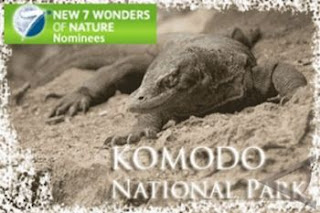| Basic Competence for SMK: | 1.3. Describing things, people, characteristics, time, day, month, and year. 3.1. Understanding and retelling monologs in a certain job situation. |
Komodo Dragon (Varanus Komodoensis)
 The Komodo dragon or the Komodo monitor (Varanus Komodoensis) is a giant monitor lizard found in Komodo island, a small semi-arid island located between the islands of Sumbawa and Flores. The prehistoric animal can also be found in several other nearby islands including Rinca island in the Indonesian archipelago.
The Komodo dragon or the Komodo monitor (Varanus Komodoensis) is a giant monitor lizard found in Komodo island, a small semi-arid island located between the islands of Sumbawa and Flores. The prehistoric animal can also be found in several other nearby islands including Rinca island in the Indonesian archipelago.The Komodo dragon, which is called "Ora" by the local people, is considered the largest lizard and the last of their kind remaining in the world today. It can grow up to 3 to 4 meters in length and run at the speed of up to 24 kilometers per hour.
The Komodo dragons use their forked tongue to sample the air for scents. Their eyesight is good for distinguishing movement and color as far away as 300 metres (980 ft) except in low light. Despite their visible earholes, they are only able to hear sounds between 400hz up to 2000 Hz. The giant monitor lizards, whose ancestors roamed the earth half a million years ago, are characterized by their short legs with large talons, a stout body and very long tails that can be used as weapon to crush an opponent.
 Preferring hot and dry places, the Komodo dragons typically live in dry open grassland, savanna, and tropical forest at low elevations. They are solitary animals and usually come together only to mate and feed on carrion. They sleep in caves or in gullies and among tree roots at night, and come out to feed in the morning. Female Komodo dragons can lay from 20 up to 40 eggs in a hole in the ground.
Preferring hot and dry places, the Komodo dragons typically live in dry open grassland, savanna, and tropical forest at low elevations. They are solitary animals and usually come together only to mate and feed on carrion. They sleep in caves or in gullies and among tree roots at night, and come out to feed in the morning. Female Komodo dragons can lay from 20 up to 40 eggs in a hole in the ground.Komodo dragons' diet consists of a variety of animal species. Young Komodo dragons normally feed on insects and small lizards. However, they begin to eat mice and other small mammals as they grow older. Adult komodo dragons prey on bigger animals such as pigs, goats, deer, young buffaloes, and horses. Although the Komodo dragons are considered harmless, it is advisable to keep a safe distance from them.
Exercises
A. Reading Comprehension: Answer these questions based on the text
- What is the Komodo dragon?
- Where can we find Komodo dragons?
- Please describe Komodo dragons based on their size.
- Please describe Komodo dragons based on their senses.
- Please describe Komodo dragons based on their physical appearance.
- Please name at least 5 (five) animals which are included in Komodo dragons' diet.
- What does paragraph 4 (four) talk about?
- "Komodo dragons are thought to have poor night vision." Which sentence in the above text supports this idea?
- Which sentence describes Komodo dragon as a prehistoric animal?
- "... as they grow older." (paragraph 5) What does "they" in the sentence refer to?
B. Vocabulary: Match each word with the correct meaning
|
|
- Wikipedia. Komodo Dragon. http://en.wikipedia.org/wiki/Komodo_dragon, accessed November 6, 2011 2:00 pm.
- Antor.org. Komodo Dragon Island, geography, how to get there, information about Komodo Dragons. http://www.antor.org/indonesia/komodo-dragon-island.html, accessed November 6, 2011 3:00 pm.
- Ministry of Culture and Tourism Republic of Indonesia, 2010. Indonesia Travel Planner. Jakarta.